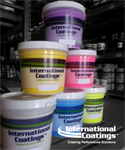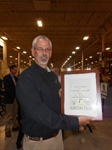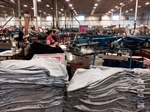
Planning and preparation are key in successful transition to automatic screen printing.
From the day we started our textile screen-printing business in 2006, my father, Bob, and I knew an automatic press was in the cards. But as with everything else, we recognized that timing and planning were critical with respect to making the leap.
Thursday, October 22, 2015/Author: Anonym/Number of views (2012)/Comments (0)/
Tags:
Tuesday, October 20, 2015/Author: Anonym/Number of views (2021)/Comments (0)/
Tags:

Doug Grigar of Vastex International gets a lot of questions about exposure, but there's one in particular, he hears the most. Here is how he addresses it.
Friday, October 16, 2015/Author: Anonym/Number of views (2087)/Comments (0)/
Tags:

New Article from Rob Coleman, Segment Marketing Manager - Nazdar SourceOne: Transitioning from plastisol- to water-based processes will require new routines and techniques, from the screenroom to the dryer. Here is a quick snapshot of some rules to live by as you make the switch:
Wednesday, October 14, 2015/Author: Anonym/Number of views (2051)/Comments (0)/
Tags:
Monday, October 12, 2015/Author: Anonym/Number of views (3638)/Comments (0)/
Tags:

Whenever we receive calls from customers who tell us our inks are not performing as expected, we ask them questions to troubleshoot the problem.
Usually, we find that the ink has not been cured properly during the printing process. However, we occasionally find that the ink wasn’t stored properly, causing it to lose some of its printing properties.
Is there really a right and wrong way to store plastisol inks? Does it really make such a difference? Absolutely! Plastisol is affected by temperature, either hot or cold, which can change the viscosity and printability of the ink.
So here are a few things to remember when storing plastisol inks:
Thursday, October 8, 2015/Author: Anonym/Number of views (2484)/Comments (0)/
Tags:

Advancing technologies allow you to increase speed and save money on screen making
Computer-to-screen (CTS) imaging dramatically is changing the way we make screens for screen printing, similar to how photo emulsions changed the process years ago.
Prior to the introduction of photo emulsions, stencils for screen making were hand cut to allow ink to pass through the open areas of the mesh. Next came photo emulsion that require film positives to expose the screen.
Today, films still are widely used, but CTS imaging is eliminating the need to make film positives for screen making altogether. (Editor's Note: Some manufacturers refer to this process as direct-to-screen imaging or DTS.)
Wednesday, October 7, 2015/Author: Anonym/Number of views (1902)/Comments (0)/
Tags:

New article from atkinsontshirt: Frequent readers will know that I have a passion for sustainability in business. It’s not an earth-crunchy, Birkenstock, hippie thing for me. It’s all about business. How did I get here though, and why do I want others to drink that same Kool-Aid? Let’s look at what just happened, and then take a few steps backwards and see.
Monday, October 5, 2015/Author: Anonym/Number of views (1958)/Comments (0)/
Tags:

With summer almost over, now is the time to start thinking about which stock inks to stock for quick customer deliveries. Here is Mark Brouillard with some tips:
Thursday, October 1, 2015/Author: Anonym/Number of views (1968)/Comments (0)/
Tags:

New post from atkinsontshirt: Got employees? How are you managing them? Hopefully with a firm and even hand, that plays out as fair, motivating, and guides people towards excellence.
Despite miraculous improvements in technology, machinery and consumables we still need employees to do the work in our shops. They are the lifeblood of our industry. If you want a prosperous company, you better treat people right.
Monday, September 28, 2015/Author: Anonym/Number of views (1966)/Comments (0)/
Tags: